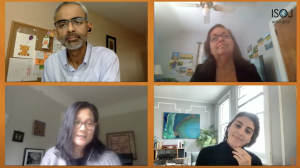May 1, 2021 | Editorial Journalism, ISOJ 2021
Opinion journalists show how publications and platforms can work to distinguish news from opinion
As social media blurs the lines between fact and opinion, informed take and angry rant, journalists, publishers and platforms need to take a more active role in distinguishing between news and opinion –both for the clarity of the reader and the quality of the journalism, according to panelists at the 2021 International Symposium on Online Journalism (ISOJ) on Friday, April 30.
The discussion was moderated by Connie Moon Sehat and Kate Harloe of the News Quality Initiative, a project of the Tow-Knight Center for Entrepreneurial Journalism at the Craig Newmark Graduate School of Journalism that works to elevate quality journalism through improving algorithms.
Vincent remarked that the general definition of opinion — a judgement, not necessarily based on fact — and the journalism definition — a fact-based point of view, with news value — are given equal footing on social media sites like Twitter, which causes confusion, exacerbated by the hyperpartisan online space and the fact that news reporters often share their personal opinions in those spaces.
López added that while news and opinion used to be distinguished by the different sections of the newspaper, those distinctions need to be rebuilt to provide more clarity for readers.
That distinction, she said, can be achieved by labeling each story clearly, both by publishers of the content and the platforms that circulate it, with journalists prepared to justify and defend the chosen category.
To further clarify this distinction, López cautions news reporters against expressing their personal opinions on social media.
“Some of this is going to come back to discipline and professionalism,” she said. “I think if you’re a news reporter, as tempting as it may be to weigh in on issues of the day, you risk your credibility.”
Vincent added that, in some cases, if journalists are transparent about their values (i.e. support of democracy) they can weigh in on certain issues, like expressing disapproval for the armed insurrection of the capitol, without losing readers’ trust.
Other suggestions included: a tab guiding readers to opinions on that topic, expanded bylines featuring more information about the writer’s background and experience level to enhance the credibility of the piece, and priority given by platforms to articles that are labeled.
There also needs to be more national and international consensus on labeling, what constitutes a news or opinion article, and what organizations are willing to publish, López said.
Since there is no unified body regulating media outlets, she hopes that outlets that choose to take these steps that will ultimately gain credibility and trust with readers. Vincent added that responsible journalists should lift up other responsible journalists, creating boundaries around “garbage, conspiracy, and non-factual commentary.”
López lamented the “sloppiness” of loaded and opinionated language used in news articles, and is hopeful that the discipline imposed by having to select labels will bring writers back to using neutral language and reserving opinion language for opinion pieces.
Vincent said this prioritization of labeling should extend to organizations, as well — a publication shouldn’t claim to be a news organization if they are only producing commentary without any original reporting.

Another challenge in the modern media sphere is the debate over the range of acceptable opinions. This range, he said, can be divided into spheres. The central one being the “sphere of consensus,” like the earth revolving around the sun, the outer one being the “sphere of deviance,” home to flat-Earth theory, and the trickiest one being the “sphere of legitimate controversy.”
This middle sphere is not settled, and there is no standardized way to determine if a point of view falls within it, he said, an uncertainty that extends to the audience.
“If the issues are not settled in a standardized way with some standards and ethics inside publishers, it will percolate downstream to the platforms,” Vincent said. “And platforms are not going to be able to sort the difference between good opinion journalism and terrible opinion journalism, if it’s not already sorted out at the source.”
Watch this workshop in English or Spanish on the ISOJ YouTube channel.

